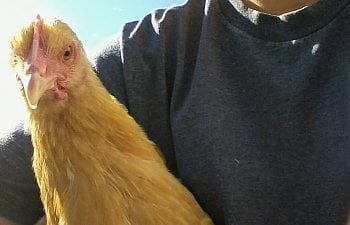This is the shortened story about our first adventures in chicken raising and keeping. It's still a little bit long, but I'll try to keep to the main points; things I think others should/would want to know, things we learned.
After much deliberation, we decided to get chickens this year. We actually thought about it, looked at pictures, and did research for about a year before we decided to jump in.
Life lesson #1- I highly suggest to anyone thinking of getting chickens, that you do your research first. I'm sure everyone has heard about someone who couldn't resist the cute little fluff balls at the feed store and got in over their heads. Read every book, blog, and Backyard Chickens post/article you can find and ideally talk to someone you know who has chickens. I maybe tend to overthink/research, but there are still things I was surprised by.

We got day old chicks mail ordered from Meyer Hatchery because that's where a friend of mine has gotten hers for years.
The breeds we chose were 2 Speckled Sussex, 2 Buff Orpington, 2 Gold Laced Wyandotte and a Blue Laced Red Wyandotte rooster to keep as the patriarch of the flock (my husband thought the picture in the catalog was "pretty"...)
We chose to have a mixed flock of three different breeds (4 if you count different colorings of the same breed) for several reasons.
1- Even though we don't live in Alaska or somewhere it gets really, really cold, we got cold hardy breeds.
2- We wanted breeds that go broody (or are more likely to go broody) so we can raise our own chicks.
3- We just liked the way they look.
4- They are dual purpose breeds that can get to a fair size. We can use the extra males we hatch or old hens for meat and actually get something from them.
5- These are all heritage breeds. Heritage breeds fit our purposes better. We aren't going to try to keep a genetically pure flock or raise them for show or anything, but we wanted heritage over hybrids, at least to start. (I know, I know. If we raise our own chicks, they'll be "mutts", unless we use the same breed males and females, but for now that's ok. We're hoping to get some Blue Laced Red Wyandotte females eventually... )
We also got 18 male Gold Laced Wyandottes to butcher for meat. (There were some follies in this decision that I'll mention later...)
So, we ordered 25 chicks in all and the hatchery sent an extra, so we had 26 total.
Everyone was healthy from the get go; exploring their brooder, checking out the food. They were so cute and small and fluffy that we left them all together for a week before we separated them. By then they were starting to get crowded in the baby brooder and the males for meat needed to be separated from everyone else.

This is a Gold Laced Wyandotte about 1 weeks old, probably a female judging by the wing development (or it could be a baby picture of Walter... he looked like a girl for so long.)
Gold Laced Wyandotte (GLW) male folly #1: The girls and the boys and my Blue Laced Red Wyandotte male all looked the same! I learned after the fact that apparently feather sexing doesn't work on Wyandottes... I did my best to guess and moved the boys to their own brooder. A little later, you could kind of tell the difference between the males and females by the rate of feather development. The females developed their feathers faster than the males. I still wasn't sure if I'd guessed correctly, so we waited a few more weeks until the wattles and combs started coming in.
If I was doing it again, I'd get a different breed meat bird; something that looked different as a chick.
 Here's the GLW males about 1.5 weeks old.
Here's the GLW males about 1.5 weeks old.
They grow so fast! You read about how messy they are, but until you witness it yourself, you really can't grasp how much mess they actually make! Our baby brooder was a large tote, which in about 2 weeks had to have a screen over it because the girls started jumping out. Later we upgraded them to a large kiddie pool wrapped in chicken wire like the boys were in. I very shortly had to pin some old towels around the chicken wire in an attempt to contain the shavings they were kicking out.

Here's the girls about 4 weeks old...
Life lesson #2- I know it seems kind of obvious, but plan your brooder ahead to accommodate the size and space needs for the amount of chicks you have. Then on top of that, add some extra space on the off chance that you can't get them out to their adult coop right on schedule. We had three different brooders that we had to use before everyone was out in their respective coops.
Some of the cute little DIY brooders you see on Pinterest seem cool, but those innocent little chicks will jump/fly out of anything less than 3 feet tall in no time flat.
About 5 weeks old, you could tell the difference between the males and females by their comb and wattle development. There was one that we thought was a GLW female, who we jokingly called Big Bertha because she was SO much bigger than all the other females. Turns out that Bertha was actually Walter, the Blue Laced Red Wyandotte male...
 This is a GLW female 5 weeks.
This is a GLW female 5 weeks.
 This is a GLW male 5 weeks.
This is a GLW male 5 weeks.
About 5 weeks old the boys needed an even bigger brooder than the kiddie pool. It was still too cold for them to go outside (besides the fact that my husband STILL hadn't even started on the coops...) They were acting crazy and definitely needed more space. So we rigged up a bigger space with cardboard walls.
Life lesson #3- I'm not sure if I'd recommend to anyone that they raise chicks in their house. Maybe if you only have a few... not 26 like we had. I certainly won't do it that way again. Thank goodness the room they were in was basically gutted for remodeling (no carpet or furnishings at all). Not only were there shavings everywhere (on the floor, being tracked down the hall into the rest of the house, in our clothes...), but there was dust EVERYWHERE. I had to do some major cleaning (of the whole house!) as soon as they moved outside, but I'm getting ahead of myself.
When the weather started getting nice during the day, we took both groups outside to play for longer and longer times. They enjoyed that and when I couldn't take them out, I'd bring in grass and herbs that I pulled, roots and all, and they enjoyed scratching and sometimes dust bathe in them.

FINALLY, my husband got the permanent, girls coop done. It's on an old single axel trailer, built from insulated fiberglass panels and roofed with metal barn roofing. It has two window (covered with 1/2 inch hardware cloth) both reclaimed (aka- free). We also reclaimed the door (aka- free), which has a window in it that can slide up and down and is the perfect size for a chicken pop door. We just flipped the door over so the window is on the bottom and viola... a (hopefully) racoon/ predator proof coop!
I'll do an article later about the building of both our coops and roughly how much it cost.

The GLW Cockrells finally moved outside to the coop while my husband finished the broiler/meat bird coop. They were about 5-6 weeks old. Two of the GLW that I thought were males, turned out to be female. The extra chick the hatchery sent was a GLW female. I only guess one female GLW correctly! When the boys eventually went outside we put the girls in the bigger brooder the boys had vacated and introduced the two GLW females to the other females with the help of an old dog crate that they had to stay in for about 2 weeks to help them all get acquainted.
Eventually when they kept escaping and we'd find them happily wandering (and pooping) around the room, I lost it and said, "Dear, those birds need to go outside NOW. Please finish the boys' coop." (I may or may not have actually said please. We'll pretend I did...) So he hurried up and finished the broiler/meat coop and we got everyone outside. (Then the house cleaning commenced.)

This is the broiler/meat bird coop. They're enclosed and they have a little hut to roost in at night that we can shut up to keep them safe. You can see the girls coop in the background.
Everone enjoyed being outside. The pullets have an electric fence around their coop so they're what's called "pasture poultry" (aka- free to range to their hearts delight within a designated safe area that's mobile and is moved to fresh grazing every so often.). I'm not sure if the Cockrells can technically be described as thus, because they're more limited, but we move their run/coop every other day to fresh grass.
Everything went along fine for several weeks. Then we had an addition to our flock when we rescued a hen at the car wash. You can check out the story of the rescue hen Fidget, here. https://www.backyardchickens.com/th...-wild-in-small-town-found-a-new-home.1174351/
My husband had to build a small pen for her until she was out of quarentine. (He really is quite handy with the power tools...)

Here's a shot of all three coops, with the little quarentine coop in the front.
Life lesson # 4- Keep notes. Even if it's a few sentences jotted down, you should keep notes whether you're brand new or an experienced keeper. (Actually experienced keepers and especially breeders probably already know this...) There will be long stretches when nothing seems to happen, then a bunch of things happen at once and you'll want to remember those things, either for fun or for scientific purposes. (What works and what doesn't, what foods they like, what brands of products YOU don't like, etc.)
When did the cockrells start to crow...? Maybe 13-14 weeks old. I should have written that down because I don't remember. The crowing was hilarious at first. They were so earnest and so pathetic! They've since gotten better, but in the begining it was quite commical.
You'd think that 19 roosters would crow all day everyday to the point of insanity, but they don't. They might go hours without a peep, then something will set one off and the others have to join in. It might last 5 minutes or 15. They don't ALL crow at the same time either. Maybe 2-4 at once; they're pretty good about taking turns. I kind of worried it would bother our new neighbors that are closest to us, but hey, we live in the country so they need to get used to it. I actually can't really hear the crowing in our bedroom, even with all the windows open, so I imagine the neighbors can't really either. The neighbors on the other side of us and behind us have their own roosters, so they have nothing to complain about with ours.

Here's the GLW Cockrells about 14-15 weeks old. They haven't started being insane yet...
The pullets and Walter are getting along great. The Buff Orpingtons are more affectionate than the others, but that's what Buffs are known for. But they all come running to you when they see you walking over. The Speckles "bwawk" loudly at you, begging for treats or telling you all the newest gossip, I'm not sure which.
I just realized I never introduced everyone!
The Buffs are: Buffy and Blondie (I called them both Buffy for a while because I couldn't tell them apart... now they have colored leg bands and I sometimes call them by the correct names.)

The Speckled Sussex are: Specky and Nugget (Nugget was smaller originally, but she's catching up. The one with more white speckles is Nugget.)

The GLW girls are: Goldie Hawn, Peanut, and Honey. Peanut and Honey were the ones I thought were males. Honey is the smallest of them all. She actually looks kind of funny- like she's not formed quite right. We'll never use her eggs for breeding... I can never get all three GLW girls in the same shot, so here's 2 and Walter standing at the top of the ramp.

This is Walter, my big boy. These pictures were all taken at about 19 weeks old.

OK, back to the insanity I mentioned earlier...
GLW male folly #2- I didn't want the white broilers for my meat birds... They work for a lot of people, but I didn't want them. They grown big so fast it just doesn't seem right or healthy (for the birds or us). That was my choice, you have to make your own. If/when we do this again, I will however get some kind of bird that meets in the middle: faster than the heritage, slower than the white broiler.
The GLW males when they hit about 16 weeks old got crazy! I guess it's the male chicken hormones or something, but they chase each other around, bite each other, grab at neck/wing feathers, all while screaming/squealing/squawking at the top of their lungs. Now, they don't do this 24/7. It's fairly warm out right now (see the next life lesson for more about that), so they're too hot to be run in around, but especially at bedtime, they're like a bunch of toddlers raising a fuss.

We actually have one in the dog crate right now because they pecked at him so much he has a bald patch on the top of his head and the back of his neck where the others pecked all his feathers out. (See the ones sitting on top of the dog crate? Thats about 5.5 ft off the ground. The higher the perch, the better apparently...)
They bite at our boots when we go out there, they bite our hand if we try to pick one up or even touch them. I don't know how much of this is breed, age, how many there are, the fact that they're a bunch of bachelor birds, or how much they were handled as chicks. We didn't handle them half as much as the girls because they are just going to be butchered for meat; we didn't need to bond with each one personally.
On the other hand, Walter is a good boy. He doesn't like being caught and picked up, but once I have him, he just sets there and lets me touch him and check him over. We handled him as much as the girls when he was a chick because we knew we were keeping him. So, nature vs. nurture... what do you think Puddin' Head Wilson? (It's a book by Mark Twain, check it out).
GLW male folly #3- They aren't very meaty... Supposedly they get to 9 lbs, but they aren't there yet. Maybe that's middle aged rooster size, but we aren't waiting that long.
We had a wind storm that blew over the broiler coop a couple weeks ago, damaging it. We came home to find the roosters roaming all over the yard and one had gotten hurt when the coop blew over. His leg was broken, the scales where stripped off and later we found out his wing was badly broken. We didn't want to doctor him up, just to butcher him in a month, so we went ahead and performed an act of mercy. (That's when we discovered the broken wing. He hid it well.) Poor thing didn't have much meat on him. We cooked up the bigger pieces which were pretty good if sparse and made a rather nice broth from the rest. So, I'm not expecting much meat to come from the rest when the time comes. Another reason to get a faster growing bird. (I don't think these guys meat-to-feed ratio is very good. When it's all said and done, I'll crunch numbers and see how bad it really was.)
Oh, yeah...
Life lesson #4- Heat and cold tolerant birds. The birds we got aren't only cold tolerant, they're VERY cold tolerant. Which means they have small combs and are very fluffy (part of the appealing physical characteristics that we liked about them in the first place.) BUT, they aren't heat tolerant. It's about 86° F or hotter out right now and they're toasty. Even Fidget, who is a White Leghorn (a Mediterranean breed and thus more heat tolerant) gets hot, pants and holds her wings put when it gets hot. I'm not sure what breeds would count as a mid-range, heat AND cold tolerant breed. I might have to do more research on that if we decide to get more birds...

Specky is holding her wings out from her body in this picture, so I can tell she's hot. They spend most of their day, rain or shine, under the coop where it's shady and presumably cooler. In the morning and evening they come out and roam around more. I make sure they have fresh water right next to the coop so they don't have to come out in the sun too much and they have a dust bath (which they really don't use). When it gets really hot, like today, I give them dishes of frozen veggies and/or fruit in water with ice cubes. They get nice cold water while they peck at the treats. I also put big blocks of ice in their waterers.
So, now they're all 19 weeks old now.
Walter, our Blue Laced Red Wyandotte rooster thinks he's king of the roost. He takes care of his girls, he's a good boy for his people, and he thinks he's the chicken Casanova (although the girls don't think so yet...)

Here's Fidget in her box with the girls, making friends. Hopefully in another week I can let her out and they won't all fight... we'll see.
We had our first egg yesterday! (Not counting Fidget, the rescue hen, who was laying eggs when we got her.) It was tiny and perfect, with a tiny little yolk inside and everything. (I already ate it.) I'm not sure who laid it, but my money is on either Specky (the Speckled Sussex, whose comb and wattles are really big and red) or one of the Buffs (who also have big, red combs and wattles).
My husband got the nesting boxes done just in time! I'd been nagging (ahem, I mean reminding) him for weeks.


Here's the first egg next to a normal egg from my egg supplier. Guess she's going to have to find a new customer soon!
After much deliberation, we decided to get chickens this year. We actually thought about it, looked at pictures, and did research for about a year before we decided to jump in.
Life lesson #1- I highly suggest to anyone thinking of getting chickens, that you do your research first. I'm sure everyone has heard about someone who couldn't resist the cute little fluff balls at the feed store and got in over their heads. Read every book, blog, and Backyard Chickens post/article you can find and ideally talk to someone you know who has chickens. I maybe tend to overthink/research, but there are still things I was surprised by.
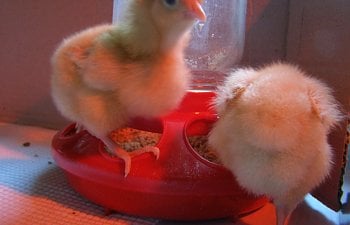
We got day old chicks mail ordered from Meyer Hatchery because that's where a friend of mine has gotten hers for years.
The breeds we chose were 2 Speckled Sussex, 2 Buff Orpington, 2 Gold Laced Wyandotte and a Blue Laced Red Wyandotte rooster to keep as the patriarch of the flock (my husband thought the picture in the catalog was "pretty"...)
We chose to have a mixed flock of three different breeds (4 if you count different colorings of the same breed) for several reasons.
1- Even though we don't live in Alaska or somewhere it gets really, really cold, we got cold hardy breeds.
2- We wanted breeds that go broody (or are more likely to go broody) so we can raise our own chicks.
3- We just liked the way they look.
4- They are dual purpose breeds that can get to a fair size. We can use the extra males we hatch or old hens for meat and actually get something from them.
5- These are all heritage breeds. Heritage breeds fit our purposes better. We aren't going to try to keep a genetically pure flock or raise them for show or anything, but we wanted heritage over hybrids, at least to start. (I know, I know. If we raise our own chicks, they'll be "mutts", unless we use the same breed males and females, but for now that's ok. We're hoping to get some Blue Laced Red Wyandotte females eventually... )
We also got 18 male Gold Laced Wyandottes to butcher for meat. (There were some follies in this decision that I'll mention later...)
So, we ordered 25 chicks in all and the hatchery sent an extra, so we had 26 total.
Everyone was healthy from the get go; exploring their brooder, checking out the food. They were so cute and small and fluffy that we left them all together for a week before we separated them. By then they were starting to get crowded in the baby brooder and the males for meat needed to be separated from everyone else.
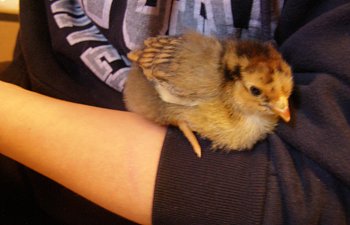
This is a Gold Laced Wyandotte about 1 weeks old, probably a female judging by the wing development (or it could be a baby picture of Walter... he looked like a girl for so long.)
Gold Laced Wyandotte (GLW) male folly #1: The girls and the boys and my Blue Laced Red Wyandotte male all looked the same! I learned after the fact that apparently feather sexing doesn't work on Wyandottes... I did my best to guess and moved the boys to their own brooder. A little later, you could kind of tell the difference between the males and females by the rate of feather development. The females developed their feathers faster than the males. I still wasn't sure if I'd guessed correctly, so we waited a few more weeks until the wattles and combs started coming in.
If I was doing it again, I'd get a different breed meat bird; something that looked different as a chick.
They grow so fast! You read about how messy they are, but until you witness it yourself, you really can't grasp how much mess they actually make! Our baby brooder was a large tote, which in about 2 weeks had to have a screen over it because the girls started jumping out. Later we upgraded them to a large kiddie pool wrapped in chicken wire like the boys were in. I very shortly had to pin some old towels around the chicken wire in an attempt to contain the shavings they were kicking out.
Here's the girls about 4 weeks old...
Life lesson #2- I know it seems kind of obvious, but plan your brooder ahead to accommodate the size and space needs for the amount of chicks you have. Then on top of that, add some extra space on the off chance that you can't get them out to their adult coop right on schedule. We had three different brooders that we had to use before everyone was out in their respective coops.
Some of the cute little DIY brooders you see on Pinterest seem cool, but those innocent little chicks will jump/fly out of anything less than 3 feet tall in no time flat.
About 5 weeks old, you could tell the difference between the males and females by their comb and wattle development. There was one that we thought was a GLW female, who we jokingly called Big Bertha because she was SO much bigger than all the other females. Turns out that Bertha was actually Walter, the Blue Laced Red Wyandotte male...
About 5 weeks old the boys needed an even bigger brooder than the kiddie pool. It was still too cold for them to go outside (besides the fact that my husband STILL hadn't even started on the coops...) They were acting crazy and definitely needed more space. So we rigged up a bigger space with cardboard walls.
Life lesson #3- I'm not sure if I'd recommend to anyone that they raise chicks in their house. Maybe if you only have a few... not 26 like we had. I certainly won't do it that way again. Thank goodness the room they were in was basically gutted for remodeling (no carpet or furnishings at all). Not only were there shavings everywhere (on the floor, being tracked down the hall into the rest of the house, in our clothes...), but there was dust EVERYWHERE. I had to do some major cleaning (of the whole house!) as soon as they moved outside, but I'm getting ahead of myself.
When the weather started getting nice during the day, we took both groups outside to play for longer and longer times. They enjoyed that and when I couldn't take them out, I'd bring in grass and herbs that I pulled, roots and all, and they enjoyed scratching and sometimes dust bathe in them.
FINALLY, my husband got the permanent, girls coop done. It's on an old single axel trailer, built from insulated fiberglass panels and roofed with metal barn roofing. It has two window (covered with 1/2 inch hardware cloth) both reclaimed (aka- free). We also reclaimed the door (aka- free), which has a window in it that can slide up and down and is the perfect size for a chicken pop door. We just flipped the door over so the window is on the bottom and viola... a (hopefully) racoon/ predator proof coop!
I'll do an article later about the building of both our coops and roughly how much it cost.
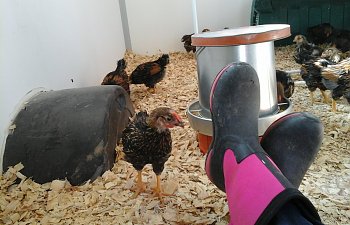
The GLW Cockrells finally moved outside to the coop while my husband finished the broiler/meat bird coop. They were about 5-6 weeks old. Two of the GLW that I thought were males, turned out to be female. The extra chick the hatchery sent was a GLW female. I only guess one female GLW correctly! When the boys eventually went outside we put the girls in the bigger brooder the boys had vacated and introduced the two GLW females to the other females with the help of an old dog crate that they had to stay in for about 2 weeks to help them all get acquainted.
Eventually when they kept escaping and we'd find them happily wandering (and pooping) around the room, I lost it and said, "Dear, those birds need to go outside NOW. Please finish the boys' coop." (I may or may not have actually said please. We'll pretend I did...) So he hurried up and finished the broiler/meat coop and we got everyone outside. (Then the house cleaning commenced.)
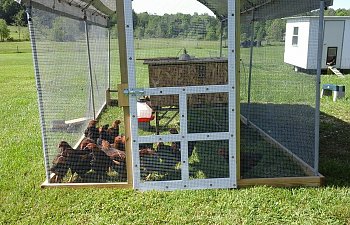
This is the broiler/meat bird coop. They're enclosed and they have a little hut to roost in at night that we can shut up to keep them safe. You can see the girls coop in the background.
Everone enjoyed being outside. The pullets have an electric fence around their coop so they're what's called "pasture poultry" (aka- free to range to their hearts delight within a designated safe area that's mobile and is moved to fresh grazing every so often.). I'm not sure if the Cockrells can technically be described as thus, because they're more limited, but we move their run/coop every other day to fresh grass.
Everything went along fine for several weeks. Then we had an addition to our flock when we rescued a hen at the car wash. You can check out the story of the rescue hen Fidget, here. https://www.backyardchickens.com/th...-wild-in-small-town-found-a-new-home.1174351/
My husband had to build a small pen for her until she was out of quarentine. (He really is quite handy with the power tools...)
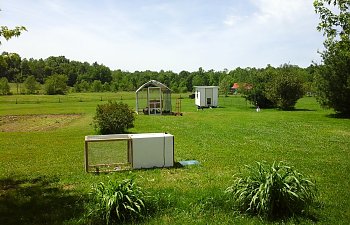
Here's a shot of all three coops, with the little quarentine coop in the front.
Life lesson # 4- Keep notes. Even if it's a few sentences jotted down, you should keep notes whether you're brand new or an experienced keeper. (Actually experienced keepers and especially breeders probably already know this...) There will be long stretches when nothing seems to happen, then a bunch of things happen at once and you'll want to remember those things, either for fun or for scientific purposes. (What works and what doesn't, what foods they like, what brands of products YOU don't like, etc.)
When did the cockrells start to crow...? Maybe 13-14 weeks old. I should have written that down because I don't remember. The crowing was hilarious at first. They were so earnest and so pathetic! They've since gotten better, but in the begining it was quite commical.
You'd think that 19 roosters would crow all day everyday to the point of insanity, but they don't. They might go hours without a peep, then something will set one off and the others have to join in. It might last 5 minutes or 15. They don't ALL crow at the same time either. Maybe 2-4 at once; they're pretty good about taking turns. I kind of worried it would bother our new neighbors that are closest to us, but hey, we live in the country so they need to get used to it. I actually can't really hear the crowing in our bedroom, even with all the windows open, so I imagine the neighbors can't really either. The neighbors on the other side of us and behind us have their own roosters, so they have nothing to complain about with ours.
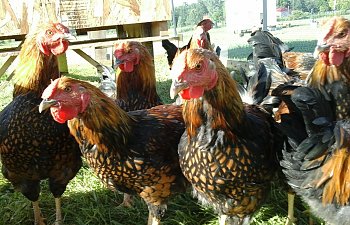
Here's the GLW Cockrells about 14-15 weeks old. They haven't started being insane yet...
The pullets and Walter are getting along great. The Buff Orpingtons are more affectionate than the others, but that's what Buffs are known for. But they all come running to you when they see you walking over. The Speckles "bwawk" loudly at you, begging for treats or telling you all the newest gossip, I'm not sure which.
I just realized I never introduced everyone!
The Buffs are: Buffy and Blondie (I called them both Buffy for a while because I couldn't tell them apart... now they have colored leg bands and I sometimes call them by the correct names.)
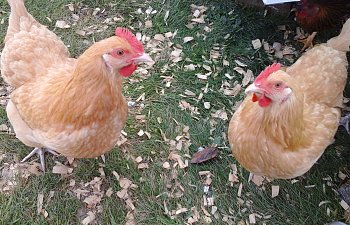
The Speckled Sussex are: Specky and Nugget (Nugget was smaller originally, but she's catching up. The one with more white speckles is Nugget.)
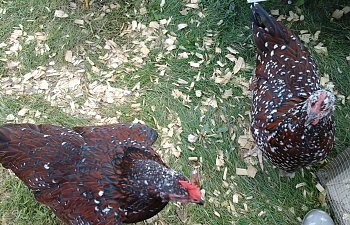
The GLW girls are: Goldie Hawn, Peanut, and Honey. Peanut and Honey were the ones I thought were males. Honey is the smallest of them all. She actually looks kind of funny- like she's not formed quite right. We'll never use her eggs for breeding... I can never get all three GLW girls in the same shot, so here's 2 and Walter standing at the top of the ramp.
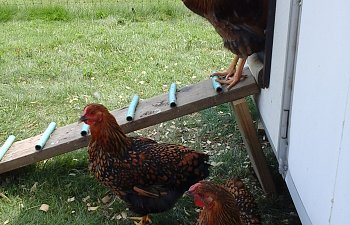
This is Walter, my big boy. These pictures were all taken at about 19 weeks old.
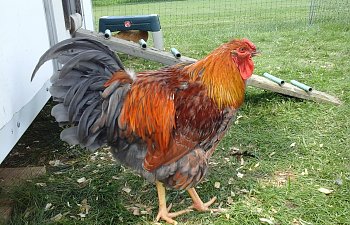
OK, back to the insanity I mentioned earlier...
GLW male folly #2- I didn't want the white broilers for my meat birds... They work for a lot of people, but I didn't want them. They grown big so fast it just doesn't seem right or healthy (for the birds or us). That was my choice, you have to make your own. If/when we do this again, I will however get some kind of bird that meets in the middle: faster than the heritage, slower than the white broiler.
The GLW males when they hit about 16 weeks old got crazy! I guess it's the male chicken hormones or something, but they chase each other around, bite each other, grab at neck/wing feathers, all while screaming/squealing/squawking at the top of their lungs. Now, they don't do this 24/7. It's fairly warm out right now (see the next life lesson for more about that), so they're too hot to be run in around, but especially at bedtime, they're like a bunch of toddlers raising a fuss.
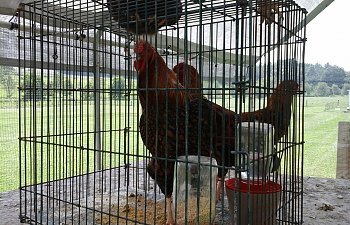
We actually have one in the dog crate right now because they pecked at him so much he has a bald patch on the top of his head and the back of his neck where the others pecked all his feathers out. (See the ones sitting on top of the dog crate? Thats about 5.5 ft off the ground. The higher the perch, the better apparently...)
They bite at our boots when we go out there, they bite our hand if we try to pick one up or even touch them. I don't know how much of this is breed, age, how many there are, the fact that they're a bunch of bachelor birds, or how much they were handled as chicks. We didn't handle them half as much as the girls because they are just going to be butchered for meat; we didn't need to bond with each one personally.
On the other hand, Walter is a good boy. He doesn't like being caught and picked up, but once I have him, he just sets there and lets me touch him and check him over. We handled him as much as the girls when he was a chick because we knew we were keeping him. So, nature vs. nurture... what do you think Puddin' Head Wilson? (It's a book by Mark Twain, check it out).
GLW male folly #3- They aren't very meaty... Supposedly they get to 9 lbs, but they aren't there yet. Maybe that's middle aged rooster size, but we aren't waiting that long.
We had a wind storm that blew over the broiler coop a couple weeks ago, damaging it. We came home to find the roosters roaming all over the yard and one had gotten hurt when the coop blew over. His leg was broken, the scales where stripped off and later we found out his wing was badly broken. We didn't want to doctor him up, just to butcher him in a month, so we went ahead and performed an act of mercy. (That's when we discovered the broken wing. He hid it well.) Poor thing didn't have much meat on him. We cooked up the bigger pieces which were pretty good if sparse and made a rather nice broth from the rest. So, I'm not expecting much meat to come from the rest when the time comes. Another reason to get a faster growing bird. (I don't think these guys meat-to-feed ratio is very good. When it's all said and done, I'll crunch numbers and see how bad it really was.)
Oh, yeah...
Life lesson #4- Heat and cold tolerant birds. The birds we got aren't only cold tolerant, they're VERY cold tolerant. Which means they have small combs and are very fluffy (part of the appealing physical characteristics that we liked about them in the first place.) BUT, they aren't heat tolerant. It's about 86° F or hotter out right now and they're toasty. Even Fidget, who is a White Leghorn (a Mediterranean breed and thus more heat tolerant) gets hot, pants and holds her wings put when it gets hot. I'm not sure what breeds would count as a mid-range, heat AND cold tolerant breed. I might have to do more research on that if we decide to get more birds...
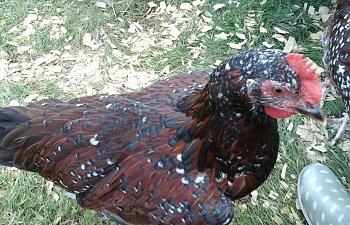
Specky is holding her wings out from her body in this picture, so I can tell she's hot. They spend most of their day, rain or shine, under the coop where it's shady and presumably cooler. In the morning and evening they come out and roam around more. I make sure they have fresh water right next to the coop so they don't have to come out in the sun too much and they have a dust bath (which they really don't use). When it gets really hot, like today, I give them dishes of frozen veggies and/or fruit in water with ice cubes. They get nice cold water while they peck at the treats. I also put big blocks of ice in their waterers.
So, now they're all 19 weeks old now.
Walter, our Blue Laced Red Wyandotte rooster thinks he's king of the roost. He takes care of his girls, he's a good boy for his people, and he thinks he's the chicken Casanova (although the girls don't think so yet...)
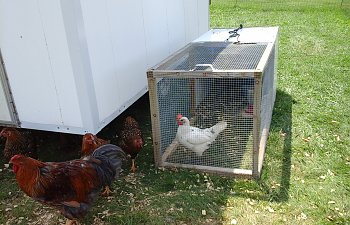
Here's Fidget in her box with the girls, making friends. Hopefully in another week I can let her out and they won't all fight... we'll see.
We had our first egg yesterday! (Not counting Fidget, the rescue hen, who was laying eggs when we got her.) It was tiny and perfect, with a tiny little yolk inside and everything. (I already ate it.) I'm not sure who laid it, but my money is on either Specky (the Speckled Sussex, whose comb and wattles are really big and red) or one of the Buffs (who also have big, red combs and wattles).
My husband got the nesting boxes done just in time! I'd been nagging (ahem, I mean reminding) him for weeks.
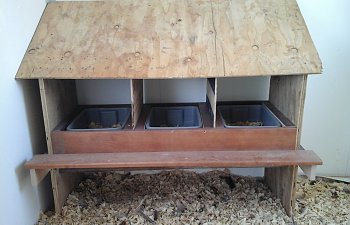
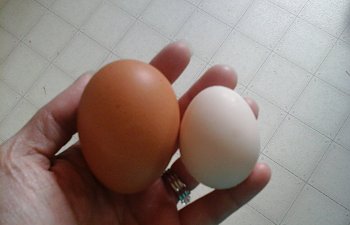
Here's the first egg next to a normal egg from my egg supplier. Guess she's going to have to find a new customer soon!

